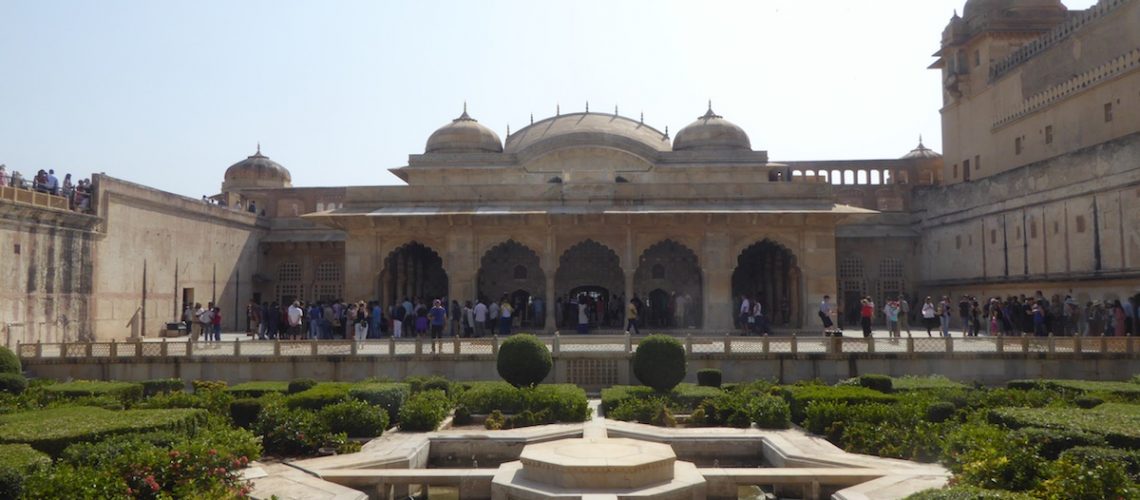The next major city on our journey is Jaipur, but en route we have an overnight stop in Pushkar. Pushkar, while unknown to me, is well known in India as a sacred destination that Hindus regularly make pilgrimages to. It’s a small town, wrapped around a small sacred lake with sacred ghats all around. The lake was created when Lord Brahma dropped a lotus flower which landed on the ground creating the lake. The town is now home to one of the few temples dedicated to Lord Brahma in the world and the only one in India.
There’s not much to the town. Aside from the lake and the ghats, there is one long bazaar selling everything from tourist that to ceremonial swords, daggers and guns (not sure if they were real, I didn’t want to ask…j. The bazaar forms the main street through the town and there is a temple up on a hill overlooking the lake that you can walk up to or take the ageing and very unsophisticated cable car. They call it a ropeway locally and it has bolts on the outside of the doors to keep them closed during the journey. We did go up the ropeway, the views at the top were extensive, and there was, as usual, a troop of monkeys at the top waiting for food or an opportunity to raid rucksacks for bounty.
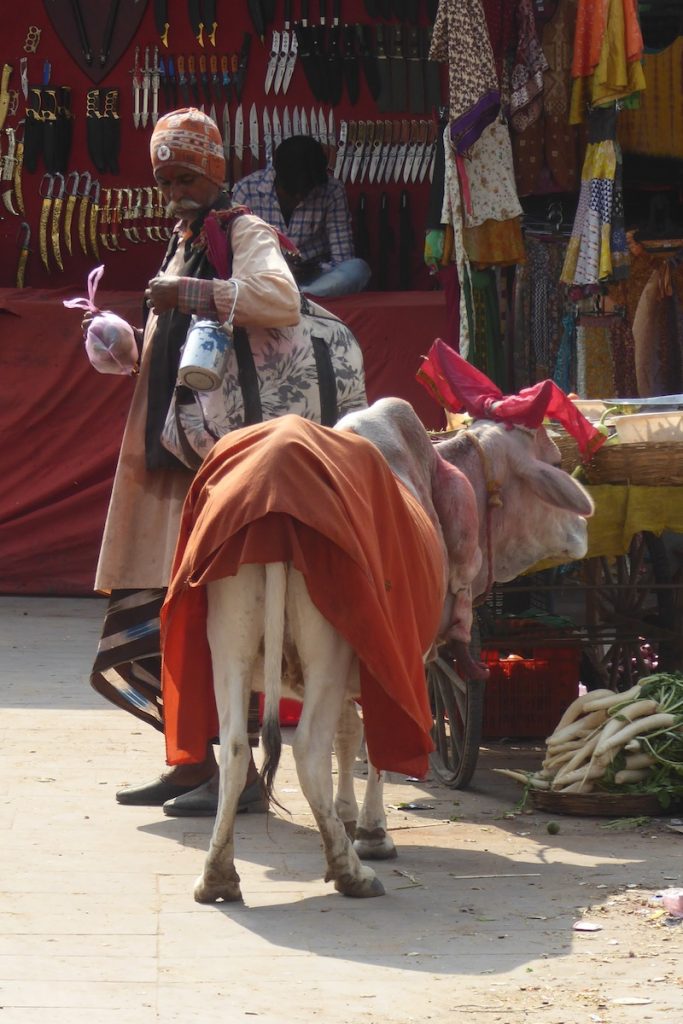
The one thing that I did see here that I’d not seen before were men parading deformed cows along the street, and requesting money whenever you so much as glance at them.
I don’t think we really felt much connection with Pushkar. Whether it was the touristy bazaar, the constant warnings about being hustled into making a personal ‘donation’ to the holy men around the ghats or just the fact that Udaipur was so lovely I don’t know. I don’t think any of the group were sad when we trekked back to Ajmer to catch a bus on to Jaipur which turned out to be an entirely different experience.
Jaipur with a population of about 4 million, is the capital of Rajasthan, and is actually the first purpose built city in Northern India, founded by the great warrior-astronomer Jai Singh II in 1727. Up until then the capital was at Amber (pronounced Am-mer) where the great Amber Fort was constructed. However increasing wealth and growth in population along with a shortage of water forced the move to a new capital.
In 1876 Maharaja Ram Singh had the entire Old City painted pink (traditionally the colour of hospitality) to welcome the Prince of Wales (later King Edward VII). This is how t has gained the title of The Pink City and to this day, residents of the Old City are compelled by law to preserve the pink façade. Today though, the colour seems very much more terracotta than pink. Either way, it gives a very different image to that of the centre of other cities we’ve visited.
The centre of town is possibly more chaotic than anywhere we’ve seen. Due to the success of the Metro in New Delhi the Indian government are commissioning other metros, one of which is being constructed in Jaipur. The roadworks just add another dimension to the chaos on the roads.
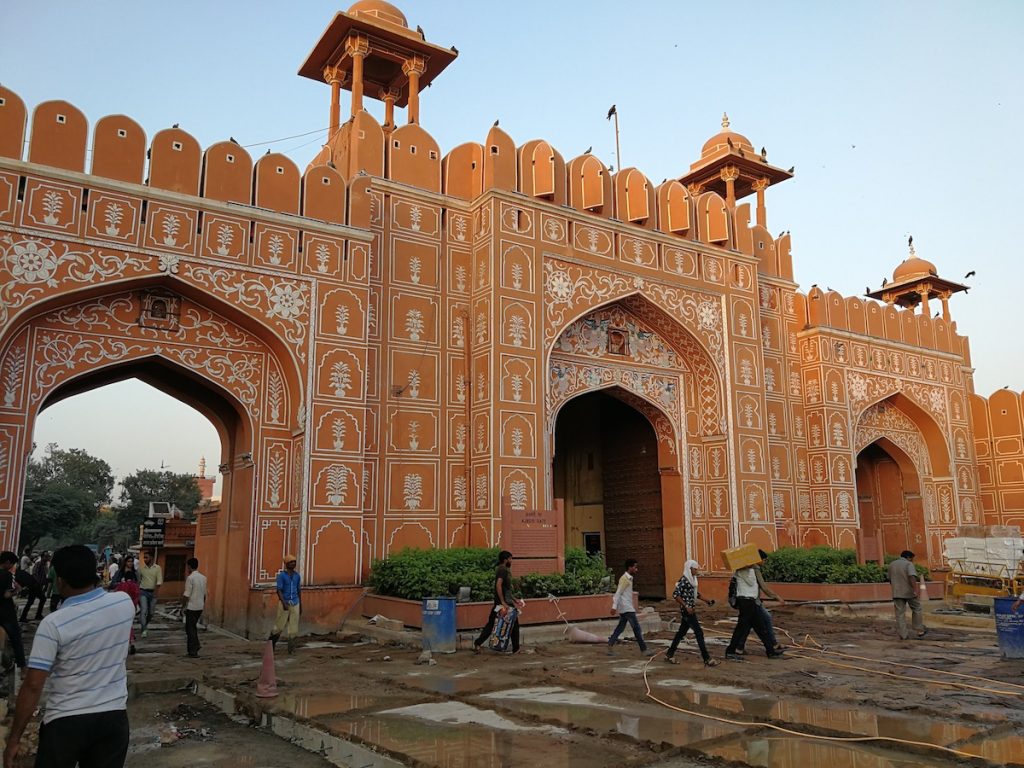
Our first evening sees a change from the usual bazaar/fort/temple visits, we head off to the cinema in town to see the newly released Bollywood hit Badhaai Ho. Apparently it’s quite a ground breaking film in the Indian film industry with on screen firsts including simulated sexual acts(!) and a gay (male) dancer. The dialogue is predominantly Hindi, but with smatterings of English, particularly from the younger actors. Although there are no subtitles, it’s relatively easy to get the gist of the plot (50 year old parents of two grown up boys have another baby creating family tensions etc.) but Sanjeev helps us with a few pointers on the plot.
It’s actually all quite entertaining, but the most amusing part of the evening is the audience reaction. Gasps of wonder, laughing, clapping and at the end dancing along with the end credits are normal and it’s hard not to get drawn into doing the same.
Back to normal state of affairs in the morning, we head off to visit the Amber Fort. It is worth dwelling on a little as it is the highlight of a visit to Jaipur.
Eleven kilometres north of the city, it was started in 1592 and was completed before the capital was moved to Jaipur. The fort sits on a rocky hillside, with (a now dry) moat at the base of the mountain and a small lake that was used as a water supply (it’s now a bright emerald green). There are steps and a zig zag road that lead up to the entrance gate. It’s a hot climb up or you can ride on an elephant. There were a constant string of elephants walking up carrying tourists, but the ethics of this are questionable. The debate over the use of wild animals for domestic purposes, and specifically tourism, can lead to heated discussion. We didn’t ride on the elephants, but they still looked spectacular painted and decked out in rich colours.
Above the Amber Fort is a second fort at the top of the hill above. Jaigarh Fort was constructed by Jai Singh in 1727 and is still used by the royal family today.
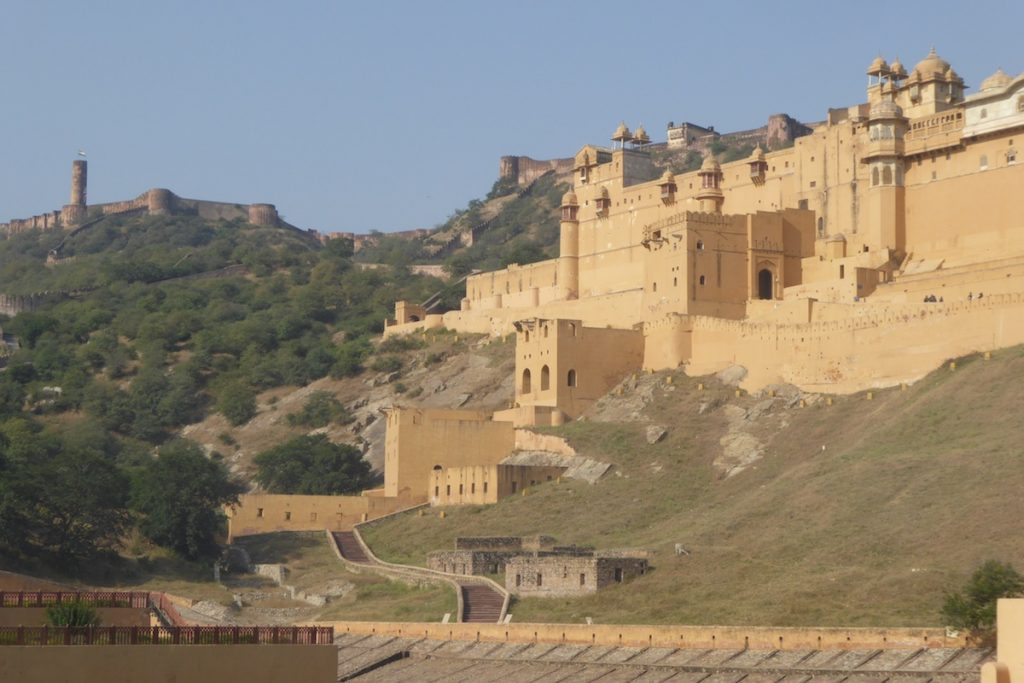
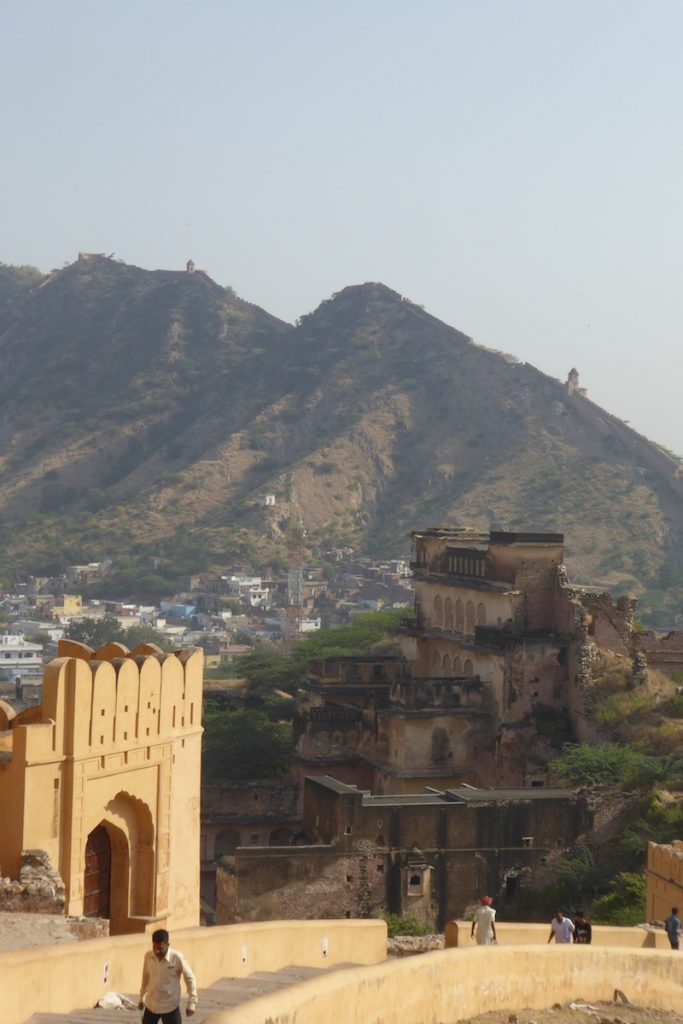
One feature of the fort is that it has the third longest perimeter wall in the world (after the Great Wall of China and the wall at the Rajasthani fort of Kumbalagh some 80km from Udaipur. It is quite spectacular, and standing at the entrance gate to the Amber Fort it is apparent in every direction. The Great Wall of China must be truly spectacular, and I’m personally disappointed that we won’t have enough time to walk around the wall (despite it looking like a very steep ascent) as it appears nearly deserted. Something I would expect to say about the Great Wall.
Back to the Amber Fort. The main courtyard is a grand sight with the elephants parading around. Taking a side path up toward the main gate rather then the main path takes us past a small temple owned by the royal family with silver doors. It’s still an active temple, and our informative guide informs us that even today a goat is sacrificed outside the doors every morning before the temple is opened. The fort itself has a couple of interesting features. There is a splendid Hall of Victory, according to our guide the largest mirrored hall in the world. Largest or not, the convex mirrors and marble panels still look glittery and glitzy today.
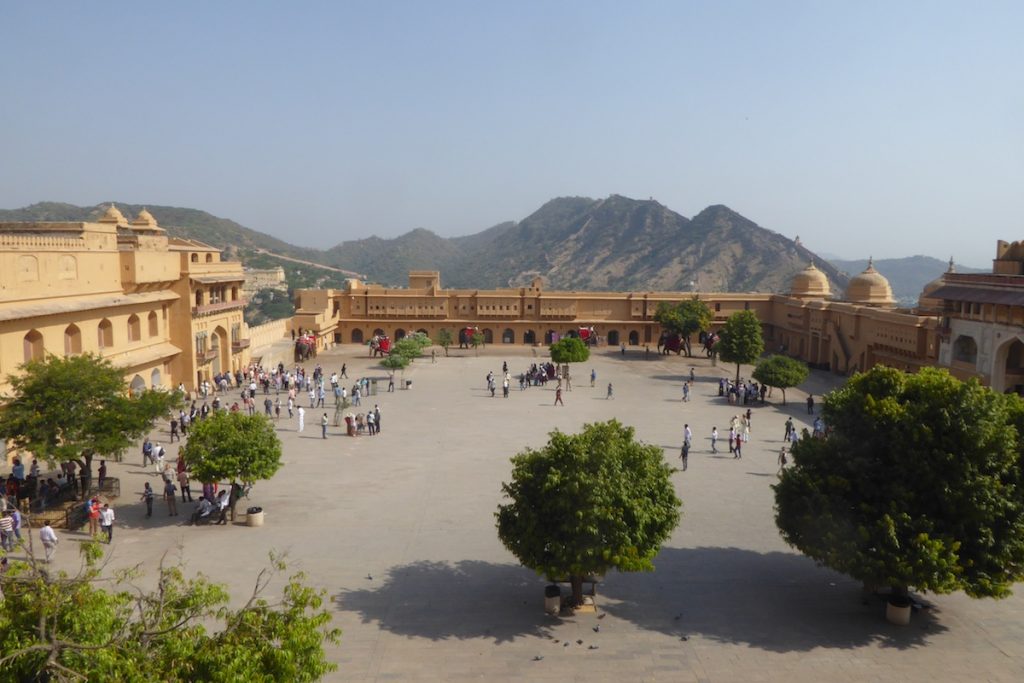
The one section (of the four parts) I found the most interesting was the zenana, or women’s quarters. Apparently Maharajah Jai Singh had quite an entourage of women amounting to 12 Queens, 3 wives and 340 concubines. Some harem! But being a Queen, wife or concubine had its drawbacks. No one was allowed to see them (they were guarded by eunuchs) and they were not allowed to leave the zenana, they spent their entire lives within their quarters. The quarters themselves were interesting, multiple levels, with rooms overlooking the courtyard. Each separate, but linked by internal corridors so that no one would know where the Maharajah actually was. You can still wander up the and get lost in the maze of corridors and stairs.
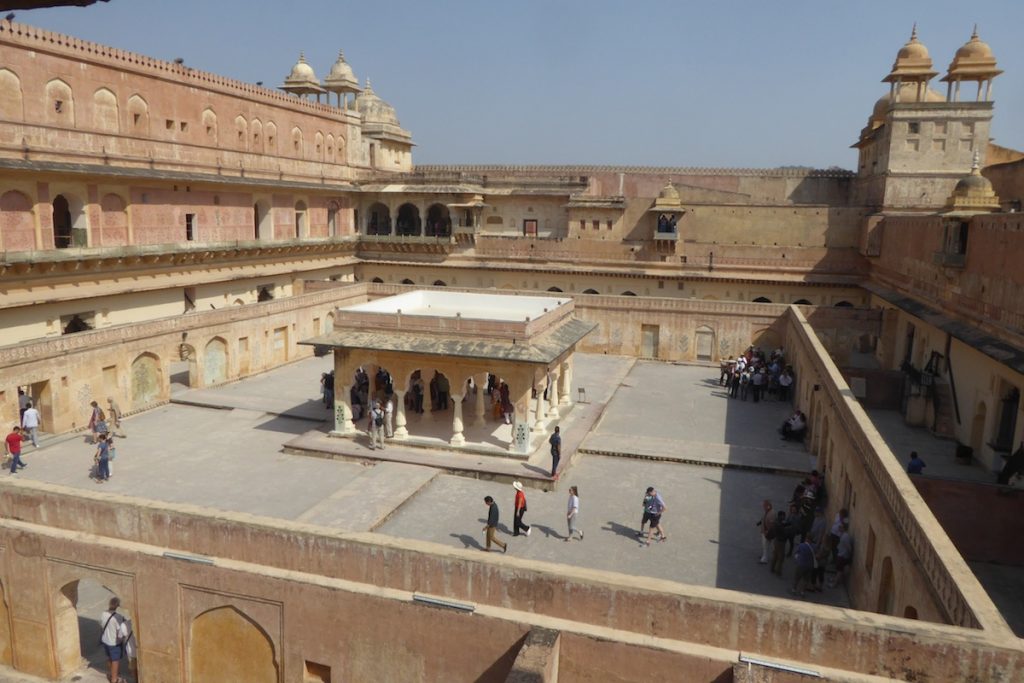
Maharajah Jai Singh II was also an enthusiastic astronomer, and he built 5 astronomic observatories across India during his life at Delhi, Varanasi, Ujjain, Mathura (of which no traces remain) and the largest and best preserved at the Jantar Mantar in Jaipur.
The observatory looks completely out of place next to the City Palace and resembles giant 50s sculptures and architecture more than a 17th century observatory. The instruments include the largest sundial in the world (it really is big!) and instruments to accurately measure the position of the sun, specifically at Jaipur, within the stellar constellations and the signs of the zodiac. I don’t pretend to understand how they used these measurements in detail but I believe it ties in with the Hindus strong astronomical beliefs. I found it really interesting, but again realised how little I know about about the Hindu beliefs and customs. Maybe I’ll do some more reading about it one day.
It turned out that our visit to Jaipur would be quite a Bollywood affair. One of the optional activities available was a Bollywood dance class. Great I think, chance for the boys to have a beer while the girls enjoy the dancing. The drawback is that minimum the number to run the class is 5, and there are only 4 girls on the trip. And Helen, whilst wanting to join in, thinks that it might be best to sit this one out. Which meant that Tony and I stepped in to the breach to make up the numbers.
Trying to describe the chaos is far too tricky. If Helen gets her way, I’m sure there will be a link to some video here, but I have to admit it was good fun. The instructor was a little slight chap (oh to have his build for dancing…) and he jumped straight in.
Do these moves. Now to music. Now these moves. From the top…
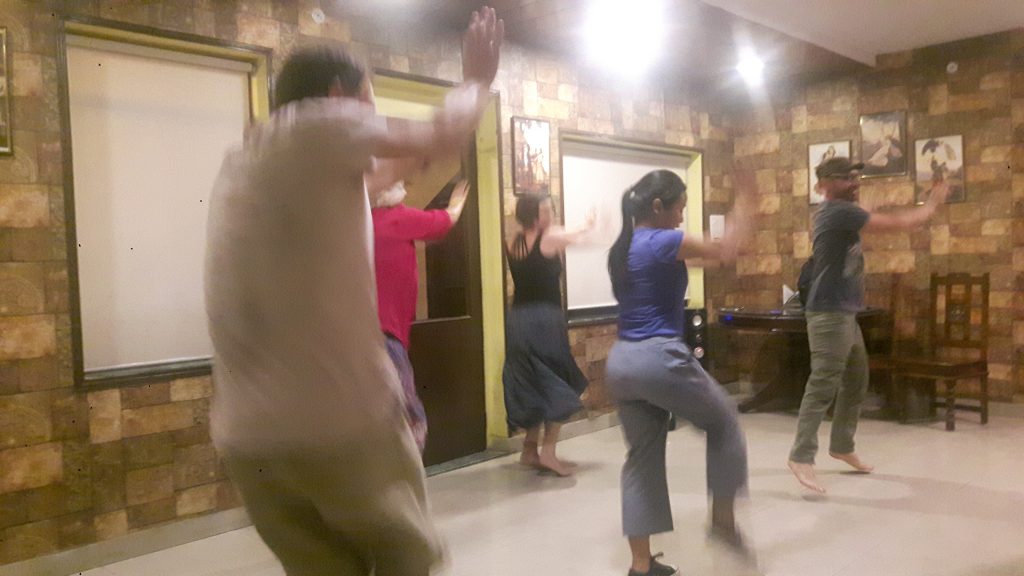
Within half an hour we’d pretty much covered the whole routine. Trying to remember moves, sequences, etc. was impossible. For me it was any way. To make matters worse, all the others who weren’t interested came and sat down to watch drinking beer!
The injury count in the morning was high, two injured ankles but still lots of smiles and laughs about our exploits.
That brought us to the end of our Jaipur exploits. Before heading on to Agra to visit the iconic Taj Mahal, we were going to stop at a boutique hotel half way at a place called Abanheri. It t was a lovely quiet setting, very rural, near to a 10th century step well and ancient temple. The room we were in was massive. In fact it was almost obscenely so. Given what we’d seen on the streets, with families literally living in the middle of the road, with no clothes or food, each room at the hotel would have probably housed 10 families. However it was a relaxing place for us, and the evening brought another local music/dance event in the form of some local men performing a traditional dance.
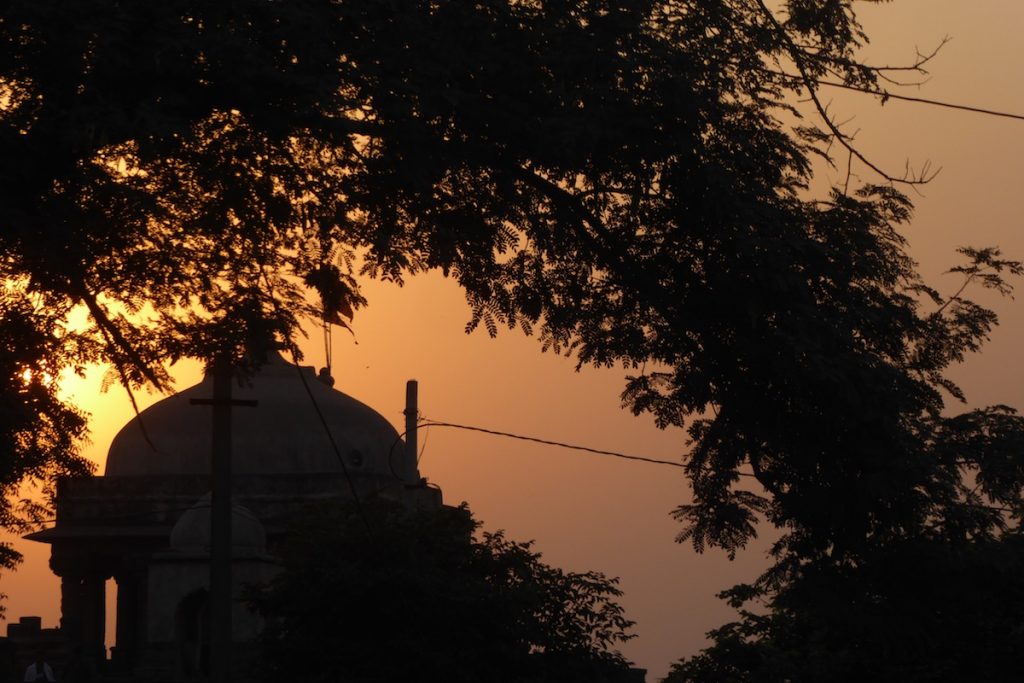
What we didn’t know was that we were expected to participate, so after a few minutes enjoying a cold beer around the camp fire we were up and dancing around it, andSanjeev joined in enthusiastically, encouraging everybody to take part. I have to say, it was even harder work than the Bollywood dancing of the previous day.
Bring on Agra, and what could be the highlight of our trip.
